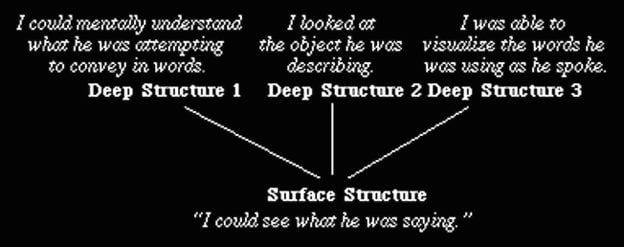Transformational grammar is a theory of grammar that accounts for the constructions of a language by linguistic transformations and phrase structures. It is also known as transformational generative grammar or T-G or TGG. In his book Syntactic Structures (1957) and later in Aspects of the theory of Syntax (1965) Chomsky tried to answer several questions left unanswered by the structuralists.
The era of transformational generative grammar signifies a sharp break with the linguistic tradition of the first half of the 20th century both in Europe and America because, having as its principal objective the formulation of a finite set of basic and transformational rules that explain how the native speaker of a language can generate and comprehend all its possible grammatical sentences, it focuses mostly on syntax and not on phonology or morphology, as structuralism does.
The new linguistics deserves the label revolutionary. After 1957, the study of grammar would no longer be limited to what is said and how it is interpreted. The word grammar itself took on a new meaning. The new linguistics defined grammar as our innate, subconscious ability to generate language, an internal system of rules that constitutes our human language capacity. The goal of the new linguistics was to describe this internal grammar.
Unlike the structuralists, whose goal was to examine the sentences we speak and to describe their systemic nature, the transformationalists wanted to unlock the secrets of language: to build a model of our internal rules, a model that would produce all of the grammatical—and no ungrammatical—sentences.
Deep and Surface Structures
When it comes to syntax, Chomsky is famous for proposing that beneath every sentence in the mind of a speaker is an invisible, inaudible deep structure, the interface to the mental lexicon. The deep structure is converted by transformational rules into a surface structure that corresponds more closely to what is pronounced and heard.

An adequate grammar must provide for the facts of the language that it is productive, complex and arbitrary. It must establish the relationship of various sentences and account for the deep and surface structure of sentences. It must, for example, explain the relationship between sets of sentences like
- (a) He wrote a letter
(b) A letter was written by him. - (a) Where do you live?
(b) You live somewhere.
- (a) He wrote a letter
As the name implies, TG grammar is both transformational and generative. It goes a step further from the structural grammar. It not only analyses the sentences, divides them into parts and shows the functions of various parts but also completely rearranges them and shows the interrelatedness between sentences. It takes up the basic or kernel sentences first. A basic or a kernel sentence is simple, assertive, declarative and active in form.
Kernel Sentences
- John is playing football.
- I wrote a letter.
- You spoke the truth.
Non-kernel sentences
- Is John playing football? (interrogative)
- John is not playing football. (negative)
- A letter was written by me. (passive)
- Who wrote the letter? (question form)
- You spoke the truth when you were forced. (complex sentence)
- You spoke the truth but told a new story. (compound sentence)
All the non-kernel sentences can be thought of as having derived from their kernel forms with the help of transformations. A sentence like Where did you go yesterday? can be derived from the kernel sentence You went somewhere yesterday, by applying certain transformations.
A sentence like Flying planes can be dangerous, is ambiguous for we cannot tell what is dangerous, the planes that fly or the act of flying planes. We can, however, resolve this ambiguity by showing that the same sentence can be analysed as being transforms from two different sets of kernel sentences. The present sentence can be derived from the following two different sets:
- Some people fly planes. This can be dangerous.
- Planes fly. They can be dangerous.
The transformational analysis thus not only shows the interrelatedness between sentences but also explains the ambiguities between sentences that appear identical but are transforms from different kernels.





























